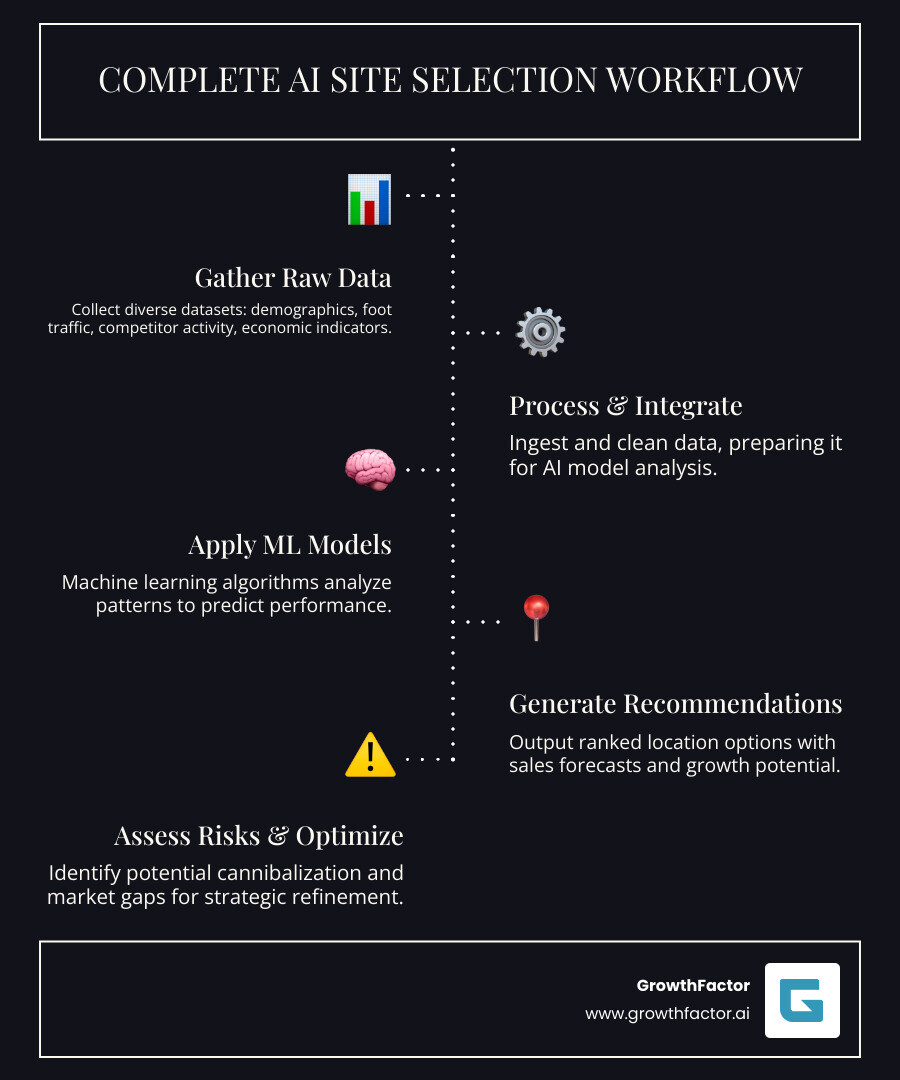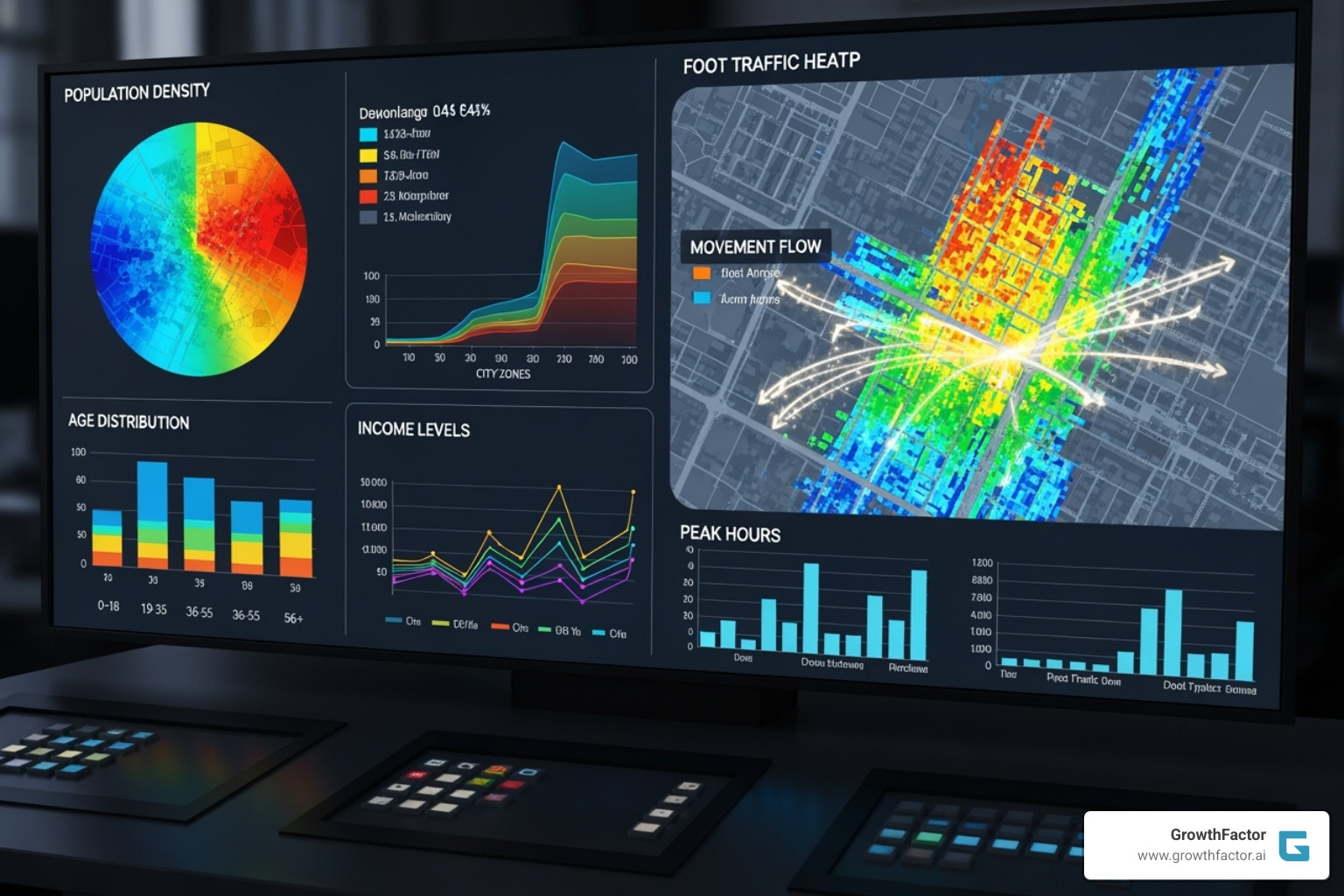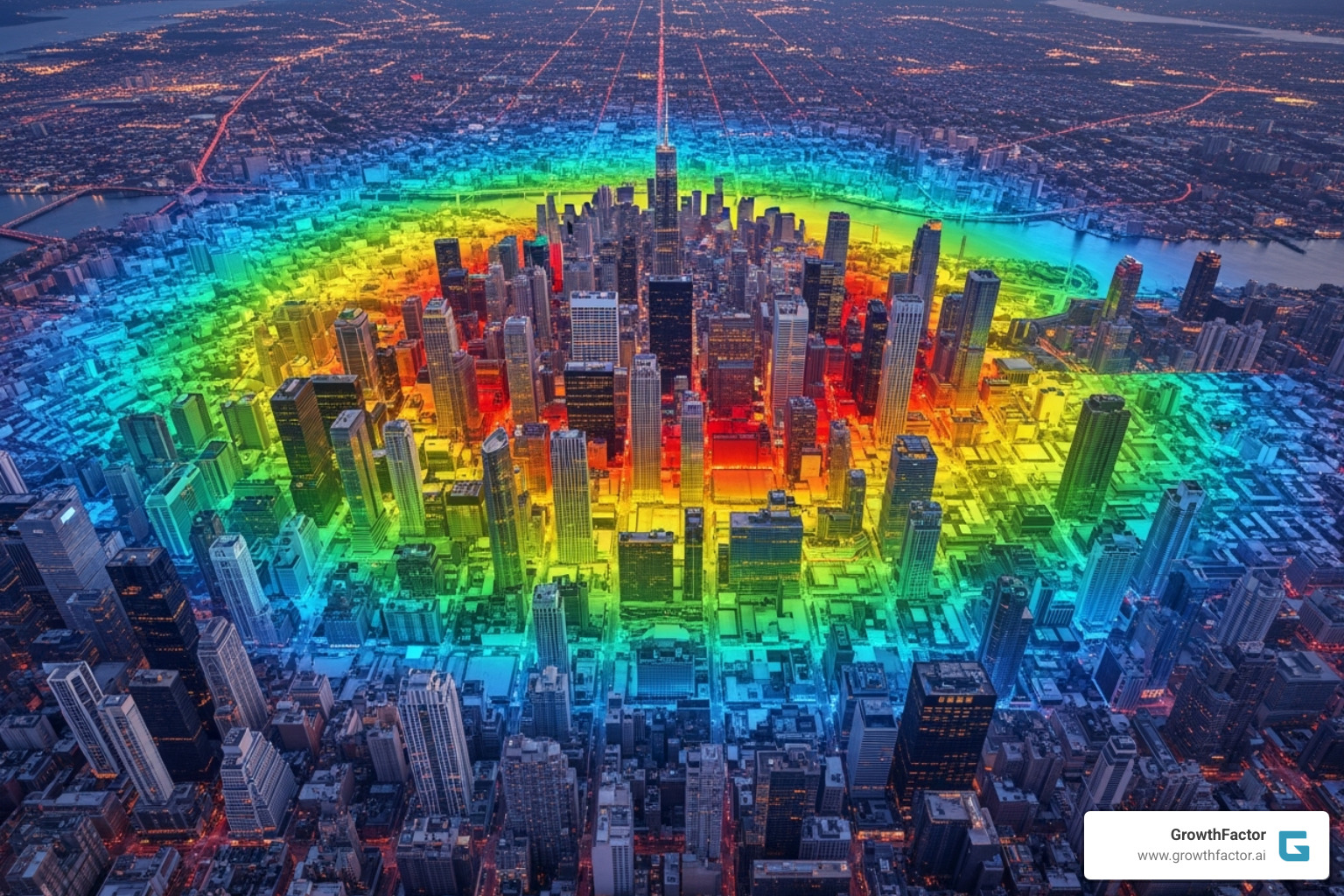Detailed Guide to AI for Site Selection
Written by: Clyde Christian Anderson
Why AI for Site Selection is Changing Retail Real Estate

AI for site selection is revolutionizing how retailers choose locations by automating data analysis, predicting performance, and identifying optimal sites faster than traditional methods. Here's what you need to know:
Key Applications:
- Predictive Analytics - Forecast sales and foot traffic potential
- Market Analysis - Analyze demographics, competition, and consumer behavior
- Risk Assessment - Identify potential cannibalization and market gaps
- Efficiency Gains - Reduce site evaluation time by up to 80%
Current Adoption:
- 38% of site selection consultants use AI for client projects
- 84% report using AI primarily for efficiency and productivity
- Only 33% fully trust AI-generated results without human oversight
Primary Benefits:
- Faster decision-making and reduced time to market
- Analysis of massive datasets impossible to process manually
- Identification of hidden patterns and market opportunities
- 15% higher sales potential when AI insights guide location decisions
The retail landscape has changed. Where site selection once relied on gut instinct, today's retailers use AI to analyze millions of data points, from foot traffic to social media sentiment.
Traditional methods can't keep pace. Manual spreadsheet analysis takes weeks, while AI platforms do it in hours, processing vast data to predict which locations will drive the highest revenue.
However, AI isn't magic. General AI platforms have significant limitations for site selection. When tested, popular tools like ChatGPT showed almost no overlap with expert-generated location lists for industrial projects and were inconsistent for office relocations.
This gap highlights why specialized platforms matter. Unlike general AI, purpose-built platforms use validated data, retail-specific algorithms, and essential human oversight for strategic decisions.
As Clyde Christian Anderson, Founder and CEO of GrowthFactor, I've seen this evolution firsthand. I went from building manual site evaluation decks to developing AI platforms that help clients achieve 99.8% success rates. My journey has taught me that the most effective approach combines artificial intelligence with human retail expertise.

AI for site selection terms simplified:
The Evolution from Traditional Methods to AI for Site Selection
Not long ago, choosing a retail location relied on gut feelings and manual data collection. It involved driving around neighborhoods, talking to local business owners, and spending weeks analyzing data in spreadsheets.
This traditional approach was painfully slow and limited. Manual data collection meant processing only a fraction of the necessary information, constrained by time, budget, and human capacity for analysis.
As retail grew more competitive, these limitations became a liability. Markets evolved faster than traditional methods could track, creating a desperate need for speed to market without sacrificing accuracy.
AI for site selection changed everything. It processes millions of variables simultaneously—from demographics to competitor performance—turning weeks of work into hours. This gives retailers the agility to seize opportunities quickly.
Here's how dramatically the landscape has shifted:
| Feature | Traditional Methods | AI-Powered Site Selection |
|---|---|---|
| Speed | Weeks to months | Hours to days |
| Data Volume | Limited, manually processed | Massive, automatically analyzed |
| Accuracy | Subjective, prone to human error | Objective, data-driven, predictive |
| Human Effort | High, repetitive tasks | Low for data processing, high for strategic oversight |
How AI is Currently Used
Today's AI for site selection is a practical tool, not a sci-fi fantasy. It doesn't make autonomous decisions. Instead, AI acts as a powerful assistant, handling data analysis while humans focus on strategy.
Administrative functions have seen the biggest change, where 84% of professionals use AI for efficiency. This includes generating reports and summarizing research, automating work that previously took hours.
More strategically, 38% of consultants now use AI for client projects. Here, artificial intelligence excels at data distillation, extracting key insights from massive datasets. This allows analysts to focus on interpreting patterns rather than drowning in spreadsheets.
While still emerging, the technology is gaining momentum. AI for site selection platforms can now analyze demographic trends, predict foot traffic, and identify market gaps with high accuracy, fundamentally shifting location intelligence.
The Shift to Data-Driven Decisions
The most profound change is philosophical: a shift from subjective decision-making based on instinct to objective analysis grounded in verifiable data. Human judgment remains crucial, but it's now informed by far richer insights.

Modern AI for site selection platforms simultaneously analyze market trends, consumer behavior patterns, and infrastructure details impossible to process manually. This includes cross-referencing demographic data with foot traffic, competitor performance, and economic indicators.
This comprehensive approach reveals opportunities and risks traditional methods miss. For example, a site with modest foot traffic might attract your ideal demographic, or a busy area could have hidden challenges like poor parking.
The shift to data-driven decisions doesn't eliminate the need for human insight; it improves it. It provides a foundation of objective analysis that makes human expertise more strategic and valuable.
Core AI Technologies and Their Applications
Understanding AI for site selection means looking at the core technologies. These are practical tools that solve real-world problems in finding the perfect business location.
Machine Learning for Predictive Analytics
Machine learning is at the core of modern AI for site selection. It teaches computers to recognize patterns in data, much like a person learns to identify what makes a neighborhood thrive.
Predictive modeling is where the magic happens. Machine learning algorithms analyze thousands of data points from successful locations—from demographics to competitor proximity—to forecast a new store's potential success.
This enables accurate sales forecasting, predicting not just if a location will work, but how well it will perform. The system identifies key success factors, such as proximity to an anchor store or a specific demographic mix.
Our guide on AI-Powered Retail Analytics: Open uping Growth Opportunities shows how these predictive models work in practice. The performance prediction capabilities help you replicate what works and avoid costly mistakes before you sign a lease.

GIS and Spatial Data Analysis
Geographic Information Systems (GIS) provide the visual foundation for AI site selection. If machine learning is the brain, GIS is the eyes, helping you visualize geographic patterns and relationships.
The power of GIS comes from data layering. By overlaying maps of zoning regulations, traffic patterns, competitor locations, and transit access, you get a complete picture of each location's unique characteristics.
This spatial analysis goes beyond simple demographics. It allows for drive-time analysis to define realistic trade areas, identify gaps in competitor coverage, and find locations that match your top-performing stores.
Proximity analysis becomes incredibly sophisticated. Instead of just measuring distance, the technology considers actual travel patterns and traffic flow. For deeper insights into these analytical capabilities, check out our resource on AI Real Estate Market Analysis.
Natural Language Processing (NLP)
Natural Language Processing (NLP) adds a human element to AI for site selection by analyzing unstructured data at scale.
NLP extracts insights from thousands of customer reviews, social media posts, and news articles. It uncovers market sentiment, neighborhood trends, and consumer preferences.
This analysis reveals what traditional reports miss, such as local excitement about a new development or customer complaints about parking at competing locations.
A key benefit is the ability to query data using plain English. Asking "Show me areas with growing families and limited competition" yields instant, data-backed answers, making powerful analysis accessible to your entire team.
NLP also helps create market narratives, turning raw data into stories that explain not just what is happening, but why it matters.
Key Benefits of Using AI for Site Selection
AI for site selection is more than a tech upgrade; it transforms how retailers evaluate locations, leading to smarter decisions and better outcomes. It reshapes the entire strategic approach to expansion.
Best Speed and Efficiency
The traditional site selection process is painfully slow. Manual data collection and analysis can delay openings by months. AI for site selection changes this by automating the heavy lifting.
What once took weeks now takes hours. AI automatically processes massive datasets and identifies promising locations, freeing human experts to focus on strategy and client relationships.
The numbers are clear: 61% of users report that AI frees up human resources for higher-value tasks. Instead of repetitive data work, analysts can evaluate more sites, dive deeper into market dynamics, and help clients make faster decisions. This speed creates a competitive advantage.
Deeper, Actionable Insights
Traditional analysis is often surface-level. AI for site selection goes deeper, uncovering patterns and insights that human analysis cannot detect.

For example, AI performs void analysis by scanning thousands of shopping centers to find tenant gaps that match your brand. In foot traffic analysis, it reveals customers' true origins, not just arbitrary radiuses. These insights turn hunches into strategic advantages.
AI also identifies hidden correlations, such as finding that locations near certain businesses consistently outperform or that specific demographic mixes predict higher customer lifetime value. These insights often surprise experienced professionals.
For retailers serious about expansion, this analytical power proves invaluable. Our guide on The Importance of Foot Traffic Analysis for Retail Success explores how these insights drive decision-making, while Using foot traffic analytics for acquisitions demonstrates practical applications for growth strategies.
Improved Accuracy and ROI
Choosing the wrong location is costly. AI for site selection reduces this risk through precise, data-driven forecasting that predicts performance with remarkable accuracy.
Gut-feeling decisions are replaced by objective analysis of market conditions, consumer behavior, and competitive dynamics. AI models predict sales, identify cannibalization risks, and optimize for long-term profitability.
The results are significant: AI-assisted brokers help clients generate 15% higher sales than with traditional methods. This is because AI identifies optimal locations that maximize revenue and minimize challenges.
AI also reduces risk by flagging potential problems early, from zoning issues to demographic mismatches. This proactive approach allows teams to prevent costly mistakes and build a strategic advantage.
Our comprehensive approach to Data-Driven Site Selection: Best Practices for Retail Success demonstrates how combining AI insights with human expertise creates the foundation for sustainable growth and exceptional returns on location investments.
Navigating the Challenges and Limitations
AI for site selection is powerful but not perfect. Successful implementation requires understanding its potential and its pitfalls. Treat AI as a brilliant but fallible assistant whose work needs to be double-checked.
Data Reliability and the "Black Box" Problem
The quality of AI output depends entirely on the input data. The principle of garbage in, garbage out is a fundamental truth in site selection.
Basing decisions on outdated information is a common pitfall. Some general AI models use data that is months old—an eternity in the fast-moving retail market. A million-dollar decision could be based on obsolete foot traffic data.
The "black box" problem is also a challenge. Many AI systems recommend a course of action but can't explain the reasoning, which is why only 33% of consultants trust generative AI results without validation. This lack of transparency is a major hurdle.
The solution is to demand transparency and validated data. When evaluating an AI for site selection platform, ask tough questions about data freshness, sources, and methodology. If you don't get clear answers, move on.
For a deeper dive into these complexities, AI 101 for Site Selection offers excellent insights into what you should be asking.
Overcoming Bias in AI for Site Selection
AI learns from historical data, which means it can unintentionally perpetuate existing biases and inequities that have long shaped the real estate industry.
For example, if an AI is trained on data reflecting historical underinvestment in certain neighborhoods, it may learn to avoid those areas. The algorithm sees a pattern but doesn't understand the underlying discriminatory practices that created it.
Algorithmic bias is an ethical responsibility, not just a technical problem. We must actively work to identify and correct these biases to ensure AI helps us make more equitable decisions.
The solution is human oversight at every step. This involves examining data sources, questioning biased recommendations, and maintaining diverse perspectives. AI should expand our view of viable markets, not narrow it to historical patterns.
General vs. Specialized AI Tools
A common mistake is assuming general AI tools like ChatGPT can handle specialized site selection. It's like asking a generalist to perform brain surgery; they lack the specific training and tools required.
Research confirms this. For industrial projects, general AI showed almost no overlap with expert-generated lists. For office relocations, ChatGPT 3.5 identified only 9 of 17 expert-recommended locations, while ChatGPT 4.0 found just 7.
General LLMs struggle with geographic insight, lack access to real-time proprietary data, and aren't designed for the complex analysis site selection demands. They are useful for general tasks but fall short for analyzing foot traffic, demographics, and competitive landscapes.
This is why purpose-built platforms are essential. They are designed for retail real estate with specialized algorithms, validated data, and features custom to site selection's unique challenges. It's about using the right tool for the job.
How to Integrate AI Into Your Site Selection Workflow
Adopting AI for site selection can feel daunting, but it doesn't have to be. Approach it as a gradual integration, like adding a brilliant, number-crunching new team member.
The most successful companies take a measured approach: start small, learn, and gradually expand AI capabilities. The goal is to amplify human expertise, not eliminate it.
A Step-by-Step Integration Plan
Successful AI integration starts with clear objectives. Define your specific pain points, whether it's slow data collection, difficulty analyzing markets, or a need to speed up screening. This clarity helps you avoid adopting AI for the wrong reasons.
Augment, not replace. Your team isn't becoming obsolete; they're getting superpowers. Let AI handle tedious data gathering and initial analysis. This frees your experts for strategic thinking, relationship building, and nuanced judgments that AI can't handle.
Choose specialized tools. Many companies get burned trying to use general AI for specialized work. A purpose-built platform for AI for site selection understands the nuances of real estate, like zoning laws and retail metrics.
Train your team. An AI platform is useless if your team can't use it effectively. Proper training should teach them to interpret AI insights, spot issues, and blend algorithmic recommendations with human judgment.
Keep humans in the loop. AI provides analytical power, but experienced professionals bring irreplaceable context, intuition, and strategic vision. The best results come from combining both.
For deeper insights into building a comprehensive strategy, explore our Retail Site Selection Strategy: A Comprehensive Approach.
Best Practices for AI for Site Selection
Getting AI for site selection right requires smart processes. Never trust AI outputs blindly. Even sophisticated algorithms have blind spots. Always cross-reference AI recommendations with other data sources and your team's local market knowledge.
Combine digital insights with on-the-ground intelligence. AI is great for identifying promising locations, but nothing replaces visiting a site and understanding local dynamics. Use AI to narrow your focus, then use human expertise for validation.
Triangulate your data. The strongest recommendations come from combining multiple sources: demographics, economic data, foot traffic, and competitor analysis. When these align, you can proceed with confidence.
Keep final authority with human experts. AI should inform and improve decision-making, not replace it. Your team's strategic understanding of the brand and market is irreplaceable.
Our guide on How to Choose a Retail Location: A Data-Driven Guide offers additional insights into making these critical choices effectively.
Real-World Success with a Hybrid Approach
The power of this hybrid approach is clear in practice. Consider a retail brand we worked with that needed to expand rapidly across multiple markets.
Our AI platform analyzed thousands of locations across dozens of markets, evaluating demographics, foot traffic, and sales potential. This screening, which would have taken months manually, was done in days, identifying the most promising data-driven opportunities.
This is where human expertise became invaluable. Our analysts added strategic thinking, conducting site visits, evaluating local conditions, and assessing deal dynamics—tasks no algorithm can perform.
The AI handled the analysis, while human experts applied contextual knowledge and strategic judgment. This hybrid approach led to faster market entry, more accurate selections, and stronger store performance.
You can read more about how businesses achieve similar growth results in our Customer Stories: How Businesses Achieve Growth with GrowthFactor.
The Future of Location Intelligence
The world of AI for site selection is constantly evolving with new breakthroughs and smarter algorithms. The evolution from guesswork to AI-powered precision is exciting, and the future holds even more promise.
Hyper-Automation and Advanced Modeling
The future of AI for site selection involves handling complex workflows from start to finish. Tomorrow's AI will seamlessly integrate data streams like demographics, foot traffic, and competitor mapping in real-time.
Sophisticated algorithms are emerging that can predict market-wide ripple effects. For instance, an advanced AI model could instantly calculate how a new development will shift foot traffic and create opportunities long before it opens.
End-to-end process automation will free up more time for strategy. The true game-changer, however, is real-time data analysis. The next generation of AI will process live data feeds, providing up-to-the-minute insights, a major leap from current systems that use older data.
Dynamic trade area modeling is another exciting advancement. Instead of static circles, AI will create living trade areas that shift with traffic, seasons, and consumer habits. It will predict not just where your customers are today, but where they will be next year.
The Symbiotic Future: AI + Human Experts
The future isn't AI replacing humans; it's about the perfect partnership between artificial intelligence and human insight.
AI as a co-pilot gives analysts and brokers superhuman analytical abilities. The AI handles the heavy data processing, freeing human experts to focus on high-value tasks like relationship building, creative problem-solving, and nuanced market interpretation.
This focus on high-value tasks transforms team operations. Instead of compiling reports, analysts can focus on strategy development. Instead of mapping competitors, brokers can focus on negotiation. The time saved is redirected to irreplaceable human skills like relationship building.
The most successful professionals will be those who master this symbiotic relationship, leveraging AI insights while applying human judgment to validate and act on them.
To understand how these technological shifts are reshaping our entire industry, explore Commercial Real Estate Tech: The Future of the Industry. The change is happening faster than most people realize, and the companies that adapt early will have a significant competitive advantage.
The future of location intelligence isn't just about better technology - it's about better decision-making through the perfect blend of artificial intelligence and human expertise.
Conclusion
The evolution of AI for site selection from a futuristic concept to an essential tool is reshaping retail real estate. This technology is fundamentally changing how businesses make critical location decisions.
The benefits are clear: unprecedented speed (cutting analysis from weeks to hours), remarkable depth (uncovering insights from millions of data points), and measurable accuracy (our clients see 15% higher sales potential).
However, AI doesn't work alone. The most successful retailers use a hybrid approach, combining AI's analytical power with irreplaceable human expertise, local knowledge, and relationship-building skills.
General AI tools often fall short, which is why specialized platforms are crucial. GrowthFactor's platform is built specifically for retail, with validated data and industry-specific algorithms to address the unique challenges of business expansion.
This technology empowers our human experts. Instead of tedious data collection, our team focuses on strategy, negotiation, and relationship building. Our analysts become more valuable with AI as their co-pilot.
The future of retail expansion belongs to those who accept this collaborative approach. Combining cutting-edge AI for site selection with experienced human judgment is the key to outperforming the competition.
Ready to see how this powerful combination can transform your expansion strategy? Explore an all-in-one real estate platform for retail and find how our Core, Growth, or Enterprise plans can help you find winning locations faster and with greater confidence than ever before.
Citations
The human algorithm
Request Your demo
Schedule meeting
Or submit your information below and we'll be in touch to schedule.


